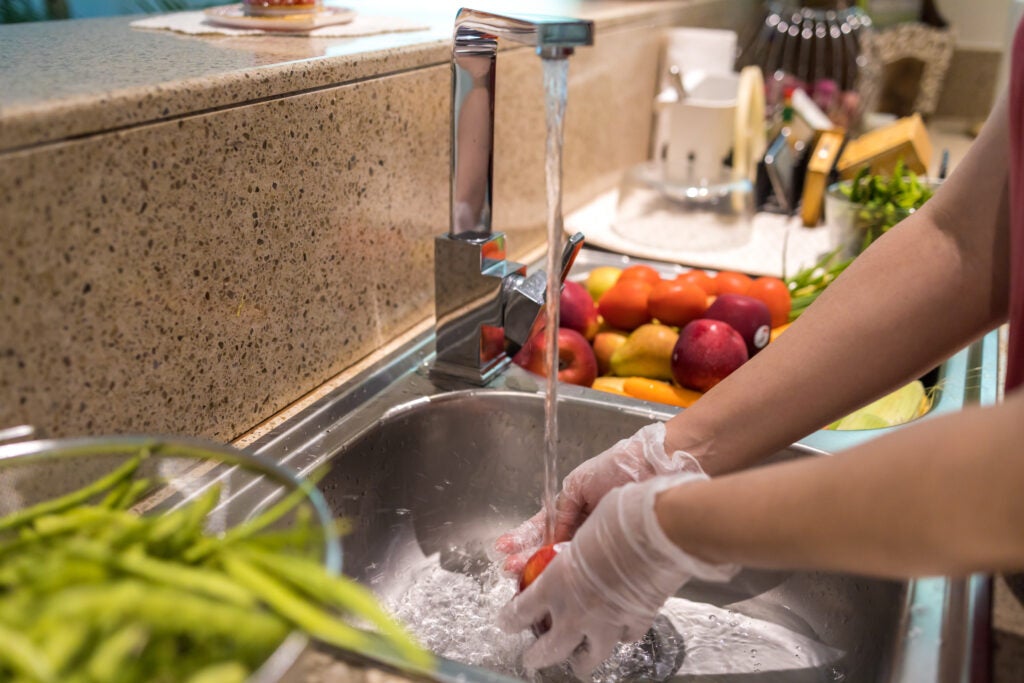September is Food Safety Education Month (FSEM). Why does food safety matter? If food is not prepared safely, it can lead to foodborne illness. According to the Centers for Disease Control and Prevention (CDC) an estimated 1 in 6 Americans each year will get a foodborne illness. The majority of these cases are mild and cause symptoms for only a day or two. Some cases are more serious. The CDC estimates there are 128,000 hospitalizations and over 3,000 deaths related to foodborne diseases each year.
Here are four ways to combat foodborne illness:
Clean hands and surfaces: Hand washing is one of the most effective ways to prevent the spread of infection and foodborne illnesses. Hands can be the most contaminated thing in the kitchen. Be aware of what you are touching and wash hands and surfaces accordingly. The proper hand-washing steps are as followed:
- Rinse your hands and exposed portion of arms with running water as hot as you can comfortably stand (at least 100F)
- Apply soap
- Vigorously rub hands and fingers together for at least 20 seconds. Clean under fingernails, between fingers/fingertips, and on surfaces of the hands/arms
- Rinse again with clean, warm, running water
- Dry hands and arms thoroughly with a single-use paper towel, a heated air dryer, or a clean, unused towel
Cook food to the proper temperature: The only way to ensure food is safe to serve and eat is to cook it to its minimum internal temperature. The minimum temperature differs based on the type of food. Once the temperature is reached, you must hold at this temperature for a specific amount of time.
| Internal Cooking Temperature | Foods |
|---|---|
| 135ºF | – Cooked vegetables – Minimum temperature for holding hot food – Minimum temperature for heating ready-to-eat foods |
| 145F for 17 seconds | – Steaks – Pork, ham, bacon – Seafood – Eggs for immediate service |
| 155F For 17 seconds | – Ground meats – Ground seafood – Raw eggs not for immediate service |
| 165F For < 1 second | – Poultry – Stuffed Foods – Raw animal-based food cooked in the microwave – Food previously cooked, cooled, and then reheated |
Promptly chill food: Bacteria grow and multiply the fastest when they are left between 41F-135F, also known as the temperature danger zone. When cooling food, you want to get it through the temperature danger zone as quickly as possible. Cool hot food from 135F (57C) to 70F (21C) within two hours and to 41F (5C) or below within four hours. Cold foods should also be kept at or below 41F (5C). Some tips to help you quickly cool food include:
- Divide food into smaller quantities
- Use an ice bath prior to refrigeration
- Using cooling tools
- Separate food into pans that are no more than 2” deep and then place in the refrigerator
Avoid Cross-Contamination: Cross-contamination is when bacteria are unintentionally transferred from one food to another food or surface. This often occurs between raw and ready-to-eat foods. Properly organizing your cooler will prevent cross-contamination and reduce the risk of foodborne illness. Ready-to-eat foods should be stored in a separate section of the cooler or on a shelf above raw foods. Raw foods with high minimum temperatures should be stored below those with lower minimum temperatures. Raw chicken that must be cooked to 165F should be stored below ground beef, which must be cooked to 155F.

Trust20 helps operators ensure they are maintaining food safety practices. To learn more about Trust20 and to find additional food safety information, including staff training topics, posters, checklists, and podcasts visit Gordon Experience®. Some examples of our training topics include:
- Personal Hygiene and Handwashing
- Food Safety for Cooks
- Food Safety for Nursing Station
- Food Safety for Concession Stand
- Foodborne Illness
- Food Safety Basics
- Food Safety Myths
- Top 10 Food Safety Concerns in a Restaurant






























